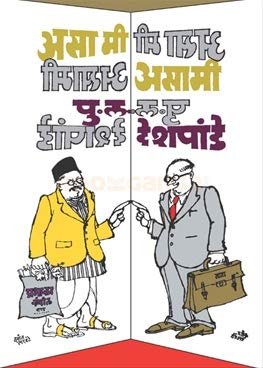I’m a Person Like This! Rating: 4.5/5 Asa Mi Asami is a humorous fictional novel written by Purushottam Laxman Deshpande, lovingly known as Pul, renowned for his observational humor, witty and light-hearted writing style. First published in 1964 by
Read More
I’m a Person Like This!
Rating: 4.5/5
Asa Mi Asami is a humorous fictional novel written by Purushottam Laxman Deshpande, lovingly known as Pul, renowned for his observational humor, witty and light-hearted writing style. First published in 1964 by Mauj Publication, Pune, this book stands out as a fictional autobiography of an ordinary man. The narrative revolves around three main themes: the humorous narration of everyday events, the struggles of a middle-class family, and the generation gap that every father faces at some point in his life.
Dhondu Bhikaji Joshi, the protagonist, there’s nothing extraordinary about Dhondu or his life to warrant an autobiography, yet most people can relate. He lives with his wife and four children, the eldest being Shankar, who is a Know-it-all and works at the Bensen and Jensen Company with other peculiar specimens, such as Nanu Saranjame from the theatre. His life is filled with small but meaningful moments, set in pre- and post-Independence India. The 116-page book also includes caricatures that depict various unfolding incidents, with a comparison showing changes before and after the salary increment in Dhondopant’s life.
The book begins with Dhondu’s relationship with his father. It then slowly, but engagingly, moves to his married life. There are humorous accounts of incidents with his wife while shopping. One notable episode involves his colleague, Kaykini Gopalrao, who takes him to a spiritual center. After the visit, Dhondu returns Gothoskardad’s blazer, that he borrowed for the trip, Gothoskardad asks him, “What did Gurudev say?” Dhondu recalls what his father used to tell him: “Bembatya Brahmadev created such a vast creation, but his favorite animal is the donkey! Therefore, even in humans, he incorporated a part of the donkey. And in the world of potters, donkeys are plentiful! Hence, the potter’s path is being followed. Be a potter. There’s no shortage of donkeys out there.”
Another amusing incident arises when Dhondu takes his family on a search for his wife’s aunt’s house. A particularly funny moment is when his children see a pig for the first time and ask, “Is that the same pig you sometimes name me after?” These occurrences are not only comical but also rich with social commentary.
Pul’s unique ability to address serious issues with humor ensures that no one feels offended while pondering the deeper truths hidden within his narrative. For instance, Dhondu comments, “I’ve seen a lot of ME,” reflecting on how many people try to present themselves as worthy of respect while their actions and words often betray them.
The novel also subtly highlights the changes over time. He touches on shifts in education, language, thought, fashion, and relationships. Even close bonds, like that of father and son, have transformed. Dhondu’s eldest son can openly discuss someone else’s love life with his father, whereas Dhondu and his father rarely speak. The changes that came with independence also impact Dhondu’s life, though his sense of freedom comes only when the British company he works for is taken over by a Shethaji. However, Dhondu critiques this “desi” takeover, observing that under Indian ownership, people ironically seem to adopt an even more British attitude, reflecting a shallow mimicry of colonial norms rather than true cultural authenticity. How the clothes you wear can serve as a reflection of the ideology you hold.
Pul created this entire character, and even the traits of an otherwise ordinary common man are subtly visible. Traits like Dhondu’s ability to listen to others, give them a chance, and ask meaningful questions are highlighted. Through Dhondu’s eyes, Pul also gives us a chance to interpret the humor, which is usually reserved for poetry. He portrays how the meaning of words can change over time, depending on the society one lives in or even through a salary increase. However, whether this change is for the greater good or not is left unanswered. Pul leaves that decision up to the readers. This ambiguity is portrayed beautifully when Dhondu reflects, saying, “Look at this picture and look at that picture.” Musing on which one is better, yet he doesn’t understand it and probably never will.
The book originally written in 1964 still managed to bring out loud laughs from me in 2024, which is probably enough to call it a classic. Even after all these years, the life structure of the middle class—where there is little to no room for art, religion, or many other aspects—is still relevant. Through keen observation, Pul has captured the essence of the common man’s life in a humorous way that everyone should read, regardless of age. There are plenty of Dhondopants around me, and in many ways, some part of Dhondu also lives within me. This lasting relatability makes the novel truly timeless.
“A clock and a person are alike—if the balance is maintained, the hands will move steadily, with no fear of going too far ahead or falling too far behind.”
Show Less

